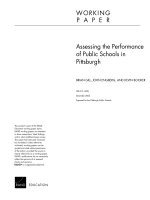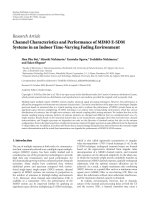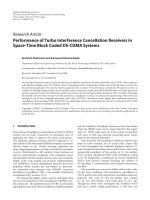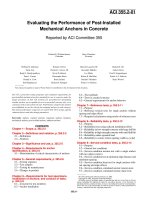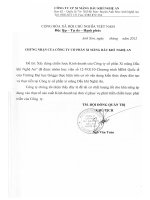Impact performance of cement composite filled pipe in pipe structures
Bạn đang xem bản rút gọn của tài liệu. Xem và tải ngay bản đầy đủ của tài liệu tại đây (6.78 MB, 248 trang )
IMPACT PERFORMANCE OF CEMENT COMPOSITE
FILLED PIPE-IN-PIPE STRUCTURES
WANG YU
NATIONAL UNIVERSITY OF SINGAPORE
2014
IMPACT PERFORMANCE OF CEMENT COMPOSITE
FILLED PIPE-IN-PIPE STRUCTURES
WANG YU
(B. Eng., HIT)
A THESIS SUBMITTED
FOR THE DEGREE OF DOCTOR OF PHILOSOPHY
DEPARTMENT OF CIVIL & ENVIRONMENTAL ENGINEERING
NATIONAL UNIVERSITY OF SINGAPORE
2014
DECLARATION
I hereby declare that this thesis is my original work and it has been written by
me in its entirety. I have duly acknowledged all the sources of information
which have been used in the thesis.
This thesis has also not been submitted for any degree in any university
previously.
Wang Yu
01 August 2014
Acknowledgement
i
ACKNOWLEDGEMENT
I wish to express my sincerest gratitude to my supervisors Professor Liew Jat Yuen, Richard,
Professor Zhang Min-Hong and Associate Professor Qian Xudong for their invaluable support,
guidance and encouragement on my research work.
Sincere thanks are further expressed to Dr. Chia Kok Seng, Dr. Kazi Md Abu Sohel, Dr. Lee
Siew Chin, Dr. Wang Tongyun, Dr. Xiong Dexin, Dr. Xiong Mingxiang, Dr. Yan Jiabao and
Ms. Zheng Jiexin for their help in my research work. Thanks are also extended to all staff
members at Concrete and Structural Engineering Laboratory for their generous, patient and
continuous help during the experiments. I would also like to thank all friends and colleagues in
National University of Singapore during the past four years for sharing with me their
happiness.
Special thanks to my parents and girlfriend for their moral supports, continuous love,
understanding and encouragement.
Finally, I would like to acknowledge the finiancial support from the Center for Offshore
Research and Engineering in the National University of Singapore and the research scholarship
provided by the China Scholarship Council.
Table o
f
contents
ii
TABLE OF CONTENTS
ACKNOWLEDGEMENT i
TABLE OF CONTENTS ii
SUMMARY vi
LIST OF TABLES viii
LIST OF FIGURES x
LIST OF SYMBOLS . xvii
CHAPTER ONE INTRODUCTION
1.1 Background 1
1.2 Objectives and Scopes 4
1.3 Significance and Contributions 6
1.4 Outline of the Thesis 6
CHAPTER TWO LITERATURE REVIEW
2.1 Introduction 8
2.2 Hollow Steel Pipes Subjected to Transverse Loads 9
2.2.1 Hollow Steel Pipes Subjected to Static Transverse Loads 9
2.2.2 Hollow Steel Pipes Subjected to Transverse Impacts 14
2.2.3 Indentation Limits for Hollow Steel Pipes 21
2.3 Steel-Concrete-Steel (SCS) Composite Panels Subjected to Transverse Loads 23
2.4 Concrete-Filled Steel Tubes (CFST) Subjected to Transverse Loads 28
2.4.1 Concrete-Filled Steel Tubes (CFST) Subjected to Static Transverse Loads 28
2.4.2 Concrete-Filled Steel Tubes (CFST) Subjected to Transverse Impacts 32
2.5 Concrete-Filled Pipe-In-Pipe Composite Structures 36
2.6 Filler Materials for Composite Structures 41
2.7 Observations Arising from the Literature Review 43
Table of contents
iii
CHAPTER THREE DROP WEIGHT IMPACT TEST
3.1 Introduction 46
3.2 Test Specimens and Set-up 47
3.2.1 Test Specimens 47
3.2.2 Ultra Lightweight Cement Composite (ULCC) 49
3.2.3 Test Set-up and Test Procedure 51
3.3 Test Results and Discussion 55
3.3.1 Damage Mechanisms 57
3.3.2 Impact Force 59
3.3.3 Global Displacement 62
3.3.4 Local Indentation 64
3.3.5 Strains 67
3.3.6 Post-peak Mean Force 72
3.3.7 Global Bending Deformation Energy 74
3.3.8 Energy Absorption Capacity 75
3.3.9 Effects of PVA Fibers 77
3.3.10 Comparison of the Impact Performance 79
3.3.11 Multiple Impacts 79
3.4 Summary 84
CHAPTER FOUR FINITE ELEMENT ANALYSIS
4.1 Introduction 87
4.2 Finite Element Modeling 88
4.2.1 Material Models 88
4.2.2 Finite Element Models 92
4.2.3 Contact Model 94
4.3 Validation of Finite Element Analysis 95
4.4 Finite Element Parametric Study 101
Table o
f
contents
iv
4.4.1 Impact Velocity Effect 102
4.4.2 Indenter Shape Effect 104
4.4.3 Inner Pipe Effect 107
4.4.4 Steel Strength Effect 108
4.4.5 Cement Composite Strength Effect 110
4.4.6 Filler Material Effect 112
4.5 Summary 113
CHAPTER FIVE LOAD-INDENTATION RELATIONSHIP
5.1 Introduction 115
5.2 Experimental Investigation 116
5.2.1 Test Specimens and Set-up 116
5.2.2 Test Results 118
5.2.3 Comparison with Analytical Models for Hollow Pipes 123
5.3 Finite Element Investigation 125
5.3.1 Finite Element Modeling 125
5.3.2 Validation of the FE Analysis 126
5.4 Load-Indentation Relationship for Hollow Pipes 129
5.5 Two-Stage Load-Indentation Formulation for Pipe-In-Pipe Composite Structures 131
5.5.1 Theoretical Model for Hollow Pipes 131
5.5.1.1 Ring model 133
5.5.1.2 Generator model 135
5.5.1.3 P-δ relationship for hollow pipes 137
5.5.2 Two-Stage Approach for Cement Composite Filled Pipe-In-Pipe Structures 137
5.5.2.1 Composite stage 138
5.5.2.2 Separation stage 142
5.5.3 Validation 143
5.6 Load-Indentation Relationship for Cement Composite Filled Pipes 147
5.6.1 Localized Indentation Phase 147
Table of contents
v
5.6.2 Indentation Propagation Phase 149
5.6.3 Load Redistribution Phase 150
5.6.4 Validation 153
5.7 Summary 154
CHAPTER SIX THEORETICAL ANALYSIS
6.1 Introduction 157
6.2 Theoretical Analysis 158
6.2.1 Dynamic Deformation Response 158
6.2.2 Load-Indentation Relationships for Simply Supported Pipes 163
6.2.3 Numerical Procedure 166
6.3 Validation of Theoretical Analysis 169
6.4 Parametric Study 176
6.4.1 Material Strength Effect 176
6.4.2 Geometric Property and Impact Velocity Effect 180
6.4.3 Validation against Numerical Simulations 185
6.4.4 Simplified Impact Response Formulation for Pipe-In-Pipe Composite Structure 188
6.5 Summary 192
CHAPTER SEVEN CONCLUSIONS
7.1 Brief Overview 194
7.2 Main Findings and Conclusions 196
7.3 Recommendations for Future Research 203
REFERENCE 204
LIST OF PUBLICATIONS 218
Summar
y
vi
SUMMARY
Circular hollow sections have wide applications in both onshore and offshore infrastructures,
including offshore jacket and jackup structures, oil and gas pipelines, etc., due to their low
resistance to fluid flow, easy handling in construction, transportation and erection. Protection
of pipelines against impact loadings has become an important concern in engineering as
external impact loadings are a primary threat and a frequent cause of damage in onshore and
offshore pipelines. Most of the current studies on this problem have focused on the impact
performance of hollow steel pipes, which demonstrate limited structural capacity under impact
loads, coupled with large global and local deformations. Concrete-filled pipe-in-pipe
composite structures have recently emerged as a popular solution to enhance the structural
resistance against external loadings. Engineering applications of such composite structures in a
harsh offshore environment requires a comprehensive understanding on the impact behavior
for these pipe-in-pipe composite structures.
The objective of this research is, therefore, to develop a framework to predict the impact
response of ultra lightweight cement composite (ULCC) filled pipe structures, validated by
detailed experimental and numerical investigations.
This study carries out drop weight impact tests to investigate the impact behavior for three
types of pipe specimens, including hollow pipe specimens, ULCC-filled pipe specimens and
ULCC-filled pipe-in-pipe specimens. Besides the experimental investigation, this study
simulates the impact process for the pipe specimens by using the nonlinear finite element (FE)
software LS-DYNA and conducts an FE parametric study to extend the understanding of the
impact performance for pipe-in-pipe composite structures.
The pipe specimens experience global deformations and local indentations under the transverse
impact. This study conducts lateral indentation tests to explore the load-indentation (P-δ)
Summary
vii
relationship for the three types of pipe specimens. Based on a combined experimental and
numerical investigation, this study proposes a two-stage approach to estimate the P-δ
relationship for pipe-in-pipe composite structures. The comparison of the P-δ relationship
calculated from the developed method with the experimental data confirms the accuracy of the
proposed approach.
Based on the proposed P-δ relationships, this study develops a new theoretical method to
predict the impact response for the three types of pipe specimens. This theoretical method
provides reliable and accurate estimations on the impact response for pipe-in-pipe composite
structures, in place of the expensive experimental tests and the computationally demanding
numerical analyses.
Compared to the hollow pipe, the ULCC-filled pipe-in-pipe composite structure demonstrates
a superior impact performance. The outer pipe and its thickness determine directly the impact
resistance and the global deformation of the composite pipe. The ULCC layer restricts
effectively the development of the local indentation. The presence of the inner pipe enhances
the confinement to the ULCC. The two-stage approach predicts closely the P-δ relationship for
the pipe-in-pipe specimens. The theoretical method provides fast and reliable estimations on
the impact response for the composite pipes.
Keywords: pipe-in-pipe composite; ultra lightweight cement composite; impact behavior,
drop weight impact test; load-indentation relationship; theoretical method.
L
ist o
f
tables
viii
LIST OF TABLES
Table 2.1 Research works for hollow steel pipes subjected to static lateral loads………… 14
Table 2.2 Research works for hollow steel pipes subjected to transverse impacts…….… 20
Table 2.3 Research works for steel-concrete-steel composite panels under dynamic loadings.44
Table 2.4 Research works for steel-concrete composite pipe structures under dynamic
loadings……………………………………………………………………………………… 45
Table 3.1 Details of the hollow steel pipe (HSP) specimens……………….………….… 47
Table 3.2 Details of the cement composite filled pipe (CCFP) specimens………………… 47
Table 3.3 Details of the cement composite filled pipe-in-pipe (CCFPIP) specimens……… 48
Table 3.4 Material properties of the ultra lightweight cement composite (ULCC) ……… 50
Table 3.5 Drop weight impact test results…………………………… ………………… 56
Table 3.6 Drop weight impact test results for multiple impacts………… 80
Table 4.1 Finite element analysis results and the comparison with the test data………… 97
Table 4.2 Comparison of the impact response for CCFPIP-2-1 under various impact
velocities…………………………………………………………………………………… 102
Table 4.3 Comparison of the impact response for CCFPIP-2-1 under different indenter
impact…………………………………………… ………………………………………….105
Table 4.4 Inner pipe effect on the impact response for pipe-in-pipe composite specimen… 107
Table 4.5 Comparison of the impact response for pipe-in-pipe composite specimens with
different steel strength……………………………………………… …………………… 109
Table 4.6 Comparison of the impact response for pipe-in-pipe composite specimens with
different cement composite strength…………………………………………… ………….111
Table 4.7 Filler material effect on the impact response for pipe-in-pipe composite
specimens…………………………………………………………………………………….112
Table 5.1 Details of the short pipe specimens in the indentation test program……….…… 117
Table 5.2
00
/Dt
ratios in the FE models for continuously supported hollow steel pipes… 130
Table 5.3 Equivalent thickness for the sandwich composite pipes in the two-stage
approach…………………………………………………………………………………… 141
Table 5.4 Indentation level at which the proposed P-δ model reaches the second stage and the
confinement factor
………………………………… ………………………………….…145
Table 5.5 Confinement factor (
) for cement composite filled pipe specimens…… …….147
List of tables
ix
Table 5.6 Prediction of the P-δ response for cement composite filled pipe specimens…… 152
Table 6.1 Theoretical prediction of the impact response for hollow pipe specimens………
170
Table 6.2 Theoretical prediction of the impact response for cement composite filled pipe
specimens…………………………………………………………………………………….
173
Table 6.3 Theoretical prediction of the impact response for pipe-in-pipe composite
specimens…………………………………………………………………………………….176
Table 6.4 Material strength effect on the impact response for hollow steel pipes…………
177
Table 6.5 Material strength effect on the impact response for cement composite filled
pipes…………………………………………………………………………………… …
177
Table 6.6 Material strength effect on the impact response for pipe-in-pipe composite
members……………………………………………………………………………………
179
Table 6.7 ratios in the theoretical parametric study for hollow pipes and cement
composite filled pipes………………………………………………………………… …….181
Table 6.8 Dimensions for pipe-in-pipe composite members in the theoretical parametric
study ………………………………………………………………… ……………………
183
Table 6.9 Details for the typical cases in the theoretical parametric study………………… 186
Table 6.10 Comparison of the impact response between the theoretical and the FE
prediction …………………………………………….…………………………………… 188
Table 6.11 Comparison of the impact response between the formulation prediction and the test
data………………………………………………………………….…… ……………… 190
Table 6.12 Comparison of the impact response calculated by the simplified formulations and
by the theoretical method ……………………… ……………………………………….….191
00
/
D
t
L
ist o
f
f
i
g
ures
x
LIST OF FIGURES
Fig. 1.1 Typical offshore infrastructures: (a) jackets and jackups; and (b) pipelines……… 2
Fig. 1.2 Concrete coating damage for pipelines (Macdonald et al., 2007).…… … 3
Fig. 1.3 The ultra lightweight cement composite (ULCC) filled pipe-in-pipe composite
structure…………………………………………………….…………….………….………….4
Fig. 1.4 Scope of the research work.………………………………………. ……… … … 5
Fig. 2.1 (a) Rings in the pipe; (b) generators in the pipe; and (c) an inextensible ring bending
about generators under the lateral indentation (Wierzbicki and Suh, 1988)… …….….………9
Fig. 2.2 High speed impact test techniques: (a) SHPBs method; and (b) gas gun impact… 15
Fig. 2.3 Low velocity impact test techniques: (a) Charpy pendulum impact; (b) Izod impact;
and (c) drop weight impact……………………………………………………………… 16
Fig. 2.4 Shear connectors and Bi-Steel: (a) headed shear connector; (b) Bi-Steel; (c) angle
shear connector; and (d) J-hook connector…………………………………….………… ….24
Fig. 2.5 Diagram for calculation of the ultimate flexural capacity of circular CFST beams….30
Fig. 3.1 Uni-axial true stress-true strain relationships for S355 steel: (a)
10.0
o
t
mm;
(b)
6.3
o
t
mm; and (c)
5.0
o
t
mm………………… ……………………………… ….….48
Fig. 3.2 Specimen preparation: (a) casting by a pump; (b) details for CCFPIP specimens; and
(c) hole with valve to connect with the pump for casting…………………… ……… …….49
Fig. 3.3 Uni-axial stress-strain relationship for the ULCC under the compression……… …51
Fig. 3.4 Damage modes of the ULCC cubes under the uni-axial compression: (a) ULCC with
PVA fibers; and (b) ULCC without PVA fibers………………………………………… ….51
Fig. 3.5 Low-velocity drop weight impact test system………………………………… ……52
Fig. 3.6 Experimental set-up for the drop weight impact test: (a) schematic diagram of the pipe
specimen; (b) simply supported pipe specimen and (c) impact test set-up……………… 54
Fig. 3.7 Saddle support……………………………… …………………………………….…55
Fig. 3.8 Comparison of the impact response for specimens with the same geometric
dimensions, material properties and drop height: (a) impact force history for HSP-3-1 and
HSP-3-2; (b) impact force history for CCFP-3-1, CCFP-3-2, CCFPIP-3-1 and CCFPIP-3-2;
(c) global displacement history for HSP-3-1 and HSP-3-2; (d) global displacement history for
CCFP-3-1, CCFP-3-2, CCFPIP-3-1 and CCFPIP-3-2; (e) local indentation profile for HSP-3-1
and HSP-3-2; and (f) local indentation profile for CCFP-3-1, CCFP-3-2, CCFPIP-3-1 and
CCFPIP-3-2…………………………………………………………………………… ….57
Fig. 3.9 Damage modes for typical specimens after the impact: (a) HSP-2-1 (
7.30
o
V
m/s);
(b) HSP-2-2 (
4.23
o
V
m/s); (c) CCFP-2-1 (
7.59
o
V
m/s); and (d) CCFPIP-2-1 (
7.56
o
V
m/s)…………………………………………………………………………………………….58
List of figures
xi
Fig. 3.10 Failure of the ULCC in the composite pipe specimens: (a) CCFP-2-1 (
7.59
o
V
m/s);
and (b) CCFPIP-2-1 (
7.56
o
V
m/s)…………………………………… ……… …… ….59
Fig. 3.11 Comparison of the impact force time history curves: (a) HSP-1-1, CCFP-1-1 and
CCFPIP-1-1; (b) HSP-1-1, HSP-1-2, HSP-2-2 and HSP-3-1; (c) CCFP-1-1, CCFP-2-1 and
CCFP-3-1; (d) CCFPIP-1-1, CCFPIP-2-1 and CCFPIP-3-1; (e) CCFPIP-4, CCFPIP-5-1 and
CCFPIP-6; and (f) CCFPIP-2-1, CCFPIP-5-1 and CCFPIP-7-1……………………… ….….60
Fig. 3.12 Comparison of the global displacement time history curves: (a) HSP-1-1, CCFP-1-1
and CCFPIP-1-1; (b) HSP-1-1, HSP-1-2, HSP-2-2 and HSP-3-1; (c) CCFP-1-1, CCFP-2-1 and
CCFP-3-1; (d) CCFPIP-1-1, CCFPIP-2-1 and CCFPIP-3-1; (e) CCFPIP-4, CCFPIP-5-1 and
CCFPIP-6; and (f) CCFPIP-2-1, CCFPIP-5-1 and CCFPIP-7-1…………………………… 64
Fig. 3.13 Comparison of the local indentation profiles: (a) HSP-1-1, CCFP-1-1 and CCFPIP-1-
1; (b) HSP-1-1, HSP-1-2, HSP-2-2 and HSP-3-1; (c) CCFP-1-1, CCFP-2-1 and CCFP-3-1;
(d) CCFPIP-1-1, CCFPIP-2-1 and CCFPIP-3-1; (e) CCFPIP-4, CCFPIP-5-1 and CCFPIP-6;
and (f) CCFPIP-2-1, CCFPIP-5-1 and CCFPIP-7-1…………………………………….….….65
Fig. 3.14 Comparison of the strain values for HSP-1-1, HSP-1-2, CCFP-1-1 and CCFPIP-1-1:
(a) average of S1-1 and S1-2 strain history; (b) average of S2-1 and S2-2 strain history;
(c) average of S3-1 and S3-2 strain history; and (d) average of S4-1 and S4-2 strain
history……………………………………………………………………….……………… 68
Fig. 3.15 Comparison of the strain values for CCFPIP-1-1, CCFPIP-2-1, CCFPIP-5-1 and
CCFPIP-7-1: (a) average of S1-1 and S1-2 strain history; (b) average of S2-1 and S2-2 strain
history; (c) average of S3-1 and S3-2 strain history; and (d) average of S4-1 and S4-2 strain
history ……………………………………………………………………………………… 70
Fig. 3.16 Comparison of the impact force versus the global displacement curves: (a) HSP-1-1,
CCFP-1-1 and CCFPIP-1-1; (b) HSP-1-1, HSP-1-2, HSP-2-2 and HSP-3-1; (c) CCFP-1-1,
CCFP-2-1 and CCFP-3-1; (d) CCFPIP-1-1, CCFPIP-2-1 and CCFPIP-3-1; (e) CCFPIP-4,
CCFPIP-5-1 and CCFPIP-6; and (f) CCFPIP-2-1, CCFPIP-5-1 and CCFPIP-7-1……………73
Fig. 3.17 Comparison of the transverse load transmission for: (a) solid cross section; and
(b) pipe-in-pipe cross section…………… ………… ………………………………… ….75
Fig. 3.18 Comparison of the PVA fiber effect on the impact response for pipe-in-pipe
composite specimens: (a) impact force history for CCFPIP-5-1 and CCFPIP-5-3; (b) impact
force history for CCFPIP-7-1 and CCFPIP-7-3; (c) global displacement history for CCFPIP-5-
1 and CCFPIP-5-3; (d) global displacement history for CCFPIP-7-1 and CCFPIP-7-3; and
(e) local indentation profiles for CCFPIP-5-1 and CCFPIP-5-3; and (f) local indentation
profiles for CCFPIP-7-1 and CCFPIP-7-3… …………………………………………….… 78
Fig. 3.19 Damage modes for CCFP-2-1 after multiple impacts: (a) first impact (
7.59
o
V
m/s);
and (b) second impact (
7.57
o
V
m/s).………………………………………. … ……….….81
Fig. 3.20 Damage modes for CCFPIP-2-1 after multiple impacts: (a) first impact (
7.56
o
V
m/s); (b) second impact (
7.57
o
V
m/s); and (a) third impact (
7.75
o
V
m/s) ……… … 82
Fig. 3.21 Impact force time history curves for typical specimens under multiple impacts:
(a) CCFP-1-1; (b) CCFPIP-1-1; (c) CCFPIP-5-1; and (d) CCFPIP-7-1 ……………….… 83
Fig. 3.22 Local indentation profiles for typical specimens under multiple impacts: (a) CCFP-1-
1; (b) CCFPIP-1-1; (c) CCFPIP-5-1; and (d) CCFPIP-7-1 …………… ….84
L
ist o
f
f
i
g
ures
xii
Fig. 4.1 Material failure surfaces for MAT_72R3 in LS-DYNA……………………… ……89
Fig. 4.2 Typical quarter-symmetric FE model of ULCC-filled pipe-in-pipe composite
specimen and simplified saddle support for the impact test simulation …………………… 92
Fig. 4.3 Typical quarter-symmetric FE model of hollow pipe specimen for the impact test
simulation ……………………… ……………………………………………….……….….93
Fig. 4.4 Typical quarter-symmetric FE model of cement composite filled pipe specimen for the
impact test simulation ……………………………………………………………………… 94
Fig. 4.5 Comparison of the impact response between the test and the FE results: (a) impact
force history for HSP-1-1 and CCFP-1-1; (b) impact force history for CCFPIP-1-1 and
CCFPIP-2-1; (c) global displacement history for HSP-1-1 and CCFP-1-1; (d) global
displacement history for CCFPIP-1-1 and CCFPIP-2-1; (e) local indentation profiles for HSP-
1-1 and CCFP-1-1; (f) local indentation profiles for CCFPIP-1-1 and CCFPIP-2-1; (g) average
of S1-1 and S1-2 strain history for HSP-1-1 and CCFP-1-1; and (h) average of S1-1 and S1-2
strain history for CCFPIP-1-1 and CCFPIP-2-1……………………………………………….96
Fig. 4.6 Normalized time history curves for CCFPIP-5-1 model in the FE simulation …… 99
Fig. 4.7 Von-mises stress contours for typical specimens at time
2
t
: (a) HSP-1-1(
7.54
o
V
m/s;
2
48.6t
ms); (b) CCFP-1-1 (
7.83
o
V
m/s;
2
23.8t
ms); (c) CCFPIP-1-1(
7.56
o
V
m/s;
2
29.8t
ms); and (d) CCFPIP-2-1 (
7.56
o
V
m/s;
2
35.0t
ms)……………………… ….100
Fig. 4.8 Damage contours for the ULCC in typical specimens at time
2
t
: (a) CCFP-1-1
(
7.83
o
V
m/s;
2
23.8t
ms); (b) CCFPIP-1-1(
7.56
o
V
m/s;
2
29.8t
ms); and (c) CCFPIP-2-
1 (
7.56
o
V
m/s;
2
35.0t
ms)………………………………………… …….………… …101
Fig. 4.9 Comparison of the impact response for CCFPIP-2-1 under various impact velocities:
(a) impact force history; (b) global displacement history; (c) local indentation profile; and
(d) average of S1-1 and S1-2 strain history……………………………………………….….103
Fig. 4.10 Comparison of the transverse force versus the global displacement curve for
CCFPIP-2-1 under the impact load (
7.5
o
V
m/s) and the static load … ………………….104
Fig. 4.11 Comparison of the impact response for CCFPIP-2-1 under different indenter impact:
(a) impact force history; (b) global displacement history; (c) local indentation profile; and
(d) average of S1-1 and S1-2 strain history………………………………………………… 106
Fig. 4.12 Comparison of the impact response between CCFPIP-2-1 and CCFHP: (a) impact
force history; (b) global displacement history; (c) local indentation profile; and (d) average of
S1-1 and S1-2 strain history………………………………………………………… ….….108
Fig. 4.13 Comparison of the impact response for pipe-in-pipe composite specimens with
different steel strength: (a) impact force history; (b) global displacement history; (c) local
indentation profile; and (d) average of S1-1 and S1-2 strain history……………………… 109
Fig. 4.14 Comparison of the impact response for pipe-in-pipe composite specimens with
different cement composite strength: (a) impact force history; (b) global displacement history;
(c) local indentation profile; and (d) average of S1-1 and S1-2 strain history………… ….110
List of figures
xiii
Fig. 4.15 Comparison of the impact response between pipe-in-pipe specimens filled with the
ULCC and the normal weight concrete: (a) impact force history; (b) global displacement
history; (c) local indentation profile; and (d) average of S1-1 and S1-2 strain history…… 113
Fig. 5.1 Experimental set-up for the lateral indentation test …………………… …….….117
Fig. 5.2 Deformation shapes for short pipe specimens after the indentation test: (a) elevation
view for CCFPIP-2; (b) top view for CCFPIP-2; (c) elevation view for HSP-2; (d) top view for
HSP-2; (e) elevation view for CCFP-2; and (f) top view for CCFP-2… ………….…… 118
Fig. 5.3 Failure mode for the cement composite in pipe-in-pipe specimens: (a) CCFPIP-2; and
(b) CCFPIP-7………………………………………………………………………… ….119
Fig. 5.4 Comparison of the lateral load versus normalized local indentation (P-δ) curves:
(a) HSP-1, CCFP-1 and CCFPIP-1; (b) HSP-1, HSP-2 and HSP-3; (c) CCFP-1, CCFP-2 and
CCFP-3; (d) CCFPIP-1, CCFPIP-2 and CCFPIP-3; (e) CCFPIP-4, CCFPIP-5 and CCFPIP-6;
and (f) CCFPIP-2, CCFPIP-5 and CCFPIP-7………….……………………… ……….… 121
Fig. 5.5 Comparison of the recorded normalized displacement at positions T1 and T2 versus
normalized indentation curves: (a) HSP-1, CCFP-1 and CCFPIP-1; (b) CCFPIP-1 and
CCFPIP-2; (c) CCFPIP-2 and CCFPIP-5; and (d) CCFPIP-5 and CCFPIP-7……………….123
Fig. 5.6 Comparison of the existing P-δ expressions with the experimental results for hollow
pipe specimens: (a) HSP-1; (b) HSP-2; and (c) HSP-3……… ………………………….….124
Fig. 5.7 Typical quarter-symmetric FE models for indentation test simulation: (a) hollow pipe
model; and (b) ULCC-filled pipe-in-pipe model……………… ……………………….… 125
Fig. 5.8 Comparison of the indentation response between the FE and the test data for HSP-3:
(a) P-δ curves; (b) Load versus recorded displacement curves; (c) Load versus top-surface
strain curves; and (d) Load versus side-surface strain curves……………………………… 127
Fig. 5.9 Comparison of the P-δ relationships in FE models with the experimental results:
(a) HSP-1 and HSP-2; (b) CCFPIP-1 and CCFPIP-2; (c) CCFPIP-3 and CCFPIP-4; and
(d) CCFPIP-5, CCFPIP-6 and CCFPIP-7…………………………………………………….128
Fig. 5.10 Recommended P-δ relationship for continuously supported hollow steel pipes:
(a) normalized P-δ curves and the fitted P-δ curve for hollow steel pipes; (b) comparison with
different yield strength and strain-hardening properties (219.1×10.0); (c) comparison with
different yield strength and strain-hardening properties (219.1×6.3); (d) thick-walled hollow
pipe 219.1×10.0; (e) thin-walled hollow pipe 219.1×6.3; and (f) thin-walled hollow pipe
219.1×5.0 ………………………….…… ….130
Fig. 5.11 Wierzbicki and Suh’s simplified shell model (1988): (a) rings in the pipe;
(b) generators in the pipe; (c) loose connection between a ring and a generator; and (d) an
inextensible ring bending about generators under the lateral indentation……………………131
Fig. 5.12 Geometry of the plastically deforming zone in the theoretical shell model
(Wierzbicki and Suh, 1988)……………………………………. ………………………… 133
Fig. 5.13 Comparison of the Mises stress distribution in FE models: (a) HSP-1; (b) HSP-2;
(c) CCFPIP-4; and (d) CCFPIP-7………………………………………………… ……… 139
L
ist o
f
f
i
g
ures
xiv
Fig. 5.14 Comparison of the shear stress distribution in FE models: (a) HSP-1; (b) HSP-2;
(c) CCFPIP-4; and (d) CCFPIP-7………………………………………………… ……… 140
Fig. 5.15 Determination of the loading area for the cement composite in pipe-in-pipe
specimens: (a) cross section in the x-z plane; and (b) cross section in the y-z plane……… 142
Fig. 5.16 Comparison of the P-δ relationships between the test results and the proposed two-
stage formulation for pipe-in-pipe composite specimens: (a) CCFPIP-1 and CCFPIP-2;
(b) CCFPIP-3 and CCFPIP-4; (c) CCFPIP-5; and (d) CCFPIP-6 and CCFPIP-7………… 144
Fig. 5.17 Relationship between the confinement factor (
) and the indentation level at the
beginning of the separation stage…………………………… …………………………… 145
Fig. 5.18 Determination of the load-resistance area for the cement composite filled pipe
specimens in the localized indentation phase: (a) cross section in the x-z plane; and (b) local
amplifying cross section in the y-z plane…………………………………………………… 148
Fig. 5.19 Determination of the load-resistance area for the cement composite filled pipe
specimens in the indentation propagation phase: (a) cross section in the x-z plane; and (b) local
amplifying cross section in the y-z plane………………………………………………… …150
Fig. 5.20 Determination of the load-resistance area for the cement composite filled pipe
specimens in the load redistribution phase: (a) cross section in the x-z plane; and (b) local
amplifying cross section in the y-z plane………………………………………………… 151
Fig. 5.21 Comparison of the P-δ relationships between the test results and the analytical
prediction for cement composite filled pipe specimens: (a) CCFP-1; (b) CCFP-2; and
(c) CCFP-3……………………………………………………………………………………154
Fig. 6.1 Comparison of the proposed P-δ relationship for continuously supported pipes with
the FE analysis for simply supported pipes subjected to lateral indentation……………… 163
Fig. 6.2 Developed P-δ relationship for simply supported hollow pipes: (a) normalized P-δ
curves and the fitted P-δ curve for hollow pipes; (b) hollow pipe 219.1×10.0; (c) hollow pipe
219.1×6.3; and (d) hollow pipe 219.1×5.0………………………………………………… 166
Fig. 6.3 Comparison of the impact response between the test result and the theoretical
prediction for hollow pipe specimens: (a) impact force history for HSP-1-1; (b) global
displacement history for HSP-1-1; (c) impact force history for HSP-1-2; (d) global
displacement history for HSP-1-2; (e) impact force history for HSP-2-2; (f) global
displacement history for HSP-2-2; (g) impact force history for HSP-3-1; and (h) global
displacement history for HSP-3-1…………………………………………………… …….171
Fig. 6.4 Comparison of the impact response between the test result and the theoretical
prediction for cement composite filled pipe specimens: (a) impact force history for CCFP-1-1;
(b) global displacement history for CCFP-1-1; (c) impact force history for CCFP-2-1;
(d) global displacement history for CCFP-2-1; (e) impact force history for CCFP-3-1; and
(f) global displacement history for CCFP-3-1……………………………………………… 172
List of figures
xv
Fig. 6.5 Comparison of the impact response between the test result and the theoretical
prediction for pipe-in-pipe composite specimens: (a) impact force history for CCFPIP-1-1 and
CCFPIP-2-1; (b) global displacement history for CCFPIP-1-1 and CCFPIP-2-1; (c) impact
force history for CCFPIP-3-1 and CCFPIP-4; (d) global displacement history for CCFPIP-3-1
and CCFPIP-4; (e) impact force history for CCFPIP-5-1 and CCFPIP-6; (f) global
displacement history for CCFPIP-5-1 and CCFPIP-6; (g) impact force history for CCFPIP-7-1;
and (h) global displacement history for CCFPIP-7-1……………………………………… 175
Fig. 6.6 Theoretical parametric study of the impact response for hollow pipes with different
material strengths: (a) comparison of the impact force history for different steel strengths; and
(b) comparison of the global displacement history for different steel strengths.……… ….177
Fig. 6.7 Theoretical parametric study of the impact response for cement composite filled pipes
with different material strengths: (a) comparison of the impact force history for different steel
strengths; (b) comparison of the global displacement history for different steel strengths;
(c) comparison of the impact force history for different cement composite strengths; and
(d) comparison of the global displacement history for different cement composite
strengths…………………………………………………………… ………………… ….178
Fig. 6.8 Theoretical parametric study of the impact response for pipe-in-pipe composite
members with different material strengths: (a) comparison of the impact force history for
different steel strengths; (b) comparison of the global displacement history for different steel
strengths; (c) comparison of the impact force history for different cement composite strengths;
and (d) comparison of the global displacement history for different cement composite
strengths.…………………………………………………………………………………… 179
Fig. 6.9 Theoretical parametric study of the impact response for hollow pipes with various
geometric dimensions subjected to different impact velocities: (a) maximum impact force;
(b) maximum global displacement; and (c) post-peak mean force ……………… …….181
Fig. 6.10 Theoretical parametric study of the impact response for cement composite filled
pipes with various geometric dimensions subjected to different impact velocities: (a) maximum
impact force; (b) maximum global displacement; and (c) post-peak mean force ……… 182
Fig. 6.11 Theoretical parametric study of the impact response for pipe-in-pipe composite
members with various geometric dimensions subjected to different impact velocities:
(a) maximum impact force; (b) maximum global displacement; and (c) post-peak mean
force ……… 184
Fig. 6.12 Comparison of the impact response between the theoretical prediction and the FE
simulation results for hollow pipes: (a) impact force history for H-1 and H-2; (b) global
displacement history for H-1 and H-2; (c) impact force history for H-3 and H-4; and (d) global
displacement history for H-3 and H-4 ……… 186
Fig. 6.13 Comparison of the impact response between the theoretical prediction and the FE
simulation results for cement composite filled pipes: (a) impact force history for F-1 and F-2;
and (b) global displacement history for H-1 and H-2 ……… 187
L
ist o
f
f
i
g
ures
xvi
Fig. 6.14 Comparison of the impact response between the theoretical prediction and the FE
simulation results for pipe-in-pipe composite members: (a) impact force history for C-1 and C-
2; (b) global displacement history for C-1 and C-2; (c) impact force history for C-3 and C-4;
and (d) global displacement history for C-3 and C-4 ……… ……….187
Fig. 6.15 Comparison of the simplified impact response formulations with the parametric study
results for pipe-in-pipe composite members: (a) maximum impact force; (b) maximum global
displacement; and (c) post-peak mean force ……………………………………………….189
List of symbols
xvii
LIST OF SYMBOLS
c
A
Cross section area of the concrete or the cement composite
s
A
Cross section area of the steel pipe
si
A
Cross section area of the inner steel pipe
so
A
Cross section area of the outer steel pipe
B Width of the contact area (DNV, 2010b)
e
B
Equivalent length for elastic response defined in Eq. (2.8)
p
B Effective length for plastic response defined in Eq. (2.9)
C
Cowper-Symonds strain rate parameter
c
C
Compressive force in the concrete or the cement composite
s
C
Compressive force in the steel pipe
si
C
Compressive force in the inner pipe for the pipe-in-pipe composite section
so
C
Compressive force in the outer pipe for the pipe-in-pipe composite section
12
,CC
Coefficients in the recommended P-δ relationship for continuously supported
hollow steel pipes
345
,,CCC
Coefficients in the recommended P-δ relationship for simply supported hollow
steel pipes
D Diameter of the pipe
i
D
External diameter of the inner pipe in the pipe-in-pipe composite structure
max
D
Maximum diameter of the pipe
min
D
Minimum diameter of the pipe
o
D
External diameter of the outer pipe in the pipe-in-pipe structure or external
diameter of the hollow steel pipe or external diameter of the steel pipe in the
cement composite filled pipe structure
a
E
Absorbed energy
c
E
Elastic modulus of the concrete or the cement composite
d
E
Kinematic energy of the pipe
L
ist o
f
s
y
mbols
xviii
g
E Impact energy dissipated by the global bending deformation
,ge
E Elastic global deformation energy of the pipe
,gp
E
Plastic global deformation energy of the pipe
i
E
Total impact energy
s
E
Young’s modulus of the steel
sa
E
Specific energy absorbing capacity (Reid, 1985)
E
Impact energy dissipated by the local indentation
crush
E
Rate of the crushing energy for rings
ext
E
Rate of the external work
gen
E
Rate of the extensional energy for generators
,gen s
E
Rate of the extensional energy for a single generator
int
E
Rate of the internal work
e
F
Force in the elastic stage defined in Eq. (2.5)
m
F
Force in the membrane stretching stage defined in Eq. (2.7)
p
F Force in the plastic stage defined in Eq. (2.6)
G Total weight of the structure
H
Drop height
c
I
Second moment of area for the concrete or the cement composite
s
I
Second moment of area for the steel pipe
si
I
Second moment of area for the inner steel pipe
so
I
Second moment of area for the outer steel pipe
2
J
Second invariant of the deviatoric stress tensor
e
K
Elastic contact stiffness of SCS composite beams (Liew et al., 2009)
p
K Plastic contact stiffness of SCS composite beams (Liew et al., 2009)
List of symbols
xix
L
Length of the pipe
f
L Crushing failure length of the cement composite in the x-z plane
o
L
Clear span length of the pipe
t
L
Total length of the cement composite under the indenter in the x-z plane
xz
L
Length of the load-resistance area of the cement composite in the x-z plane
yz
L Length of the load-resistance area of the cement composite in the y-z plane
M Bending moment
cc
M
Plastic moment capacity of the concrete or the cement composite in
compression
d
M
Total mass of the drop weight
o
M
Plastic moment capacity of the pipe wall with a unit width
sc
M
Plastic moment capacity of the steel pipe in compression
sic
M
Plastic moment capacity of the inner steel pipe in compression
sit
M
Plastic moment capacity of the inner steel pipe in tension
soc
M
Plastic moment capacity of the outer steel pipe in compression
sot
M
Plastic moment capacity of the outer steel pipe in tension
st
M
Plastic moment capacity of the steel pipe in tension
p
M Plastic moment capacity of the pipe cross section
u
M
Ultimate flexural capacity
ud
M
Dynamic plastic moment capacity
N
Axial force
o
N
Axial capacity of the pipe wall with a unit width
p
N Plastic force capacity of cross-section
Rd
N
Design axial compressive resistance (DNV, 2010b)
Sd
N
Design axial compressive force (DNV, 2010b)
L
ist o
f
s
y
mbols
xx
P
Lateral load or transverse impact force
c
P
Indentation resistance of the cement composite core
crush
P
Transient crushing force
i
P
Indentation resistance of the inner pipe
j
P Strength of the tubular joint (Lu et al., 1994)
m
P
Post-peak mean force
max
P
Maximum impact force
o
P
Indentation resistance of the outer pipe
p
P Peak load of the tubular joint (Lu et al., 1994)
s
P
Serviceability strength of the tubular joint (Lu et al., 1994)
u
P
Ultimate strength
R Radius of the pipe
c
R
External radius of the infilled cement composite cylinder
ci
R
Failure stress of the cement composite in ith direction
i
R
External radius of the inner pipe in the pipe-in-pipe composite structure
o
R
External radius of the outer pipe in the pipe-in-pipe structure or external radius
of the hollow steel pipe or external radius of the steel pipe in the cement
composite filled pipe structure
1
R
Radius of the bottom arc in a deformed ring
2
R
Radius of the upper arc in a deformed ring
S
Continuous deformation field
B
S
Local effects factor defined in Eq. (2.10)
BS
S
Coefficient defined in Eq. (2.30)
s
T
Tensile force in the steel pipe
si
T
Tensile force in the inner steel pipe
so
T
Tensile force in the outer steel pipe
List of symbols
xxi
U
Membrane stretching energy of the steel plate (Liew et al., 2009)
V
Volume
c
V
Work done by the contact force (Liew et al., 2009)
f
V Fiber volume in the concrete or the cement composite
i
V Velocity of the indenter tip
o
V Initial impact velocity
p
V
Passing velocity
r
V
Rebound velocity of the drop weight
ref
V
Reference upper bound velocity of the low-velocity impact problem
t
V
Velocity of the impact point on the pipe
0
V
Initial volume of the cement composite
12
,
VV
Tangential velocities of a deformed ring
W
Mass per unit length for metal tubes (Reid, 1985)
con
W
Work done by the concrete layer (Liew et al., 2009)
Z Plastic section modulus for the circular hollow section (CHS)
DIF Dynamic increase factor
c
DIF
Dynamic increase factor of the concrete of the cement composite
s
DIF
Dynamic increase factor of the steel
EAC
Energy absorption capacity
EI
Flexural stiffness
SEA Specific energy absorption
012
,,
aaa
User defined parameters for the maximum failure surface in MAT_72R3 in
LS-DYNA
012
,,
yy y
aaa User defined parameters for the initial yield surface in MAT_72R3 in LS-
DYNA
12
,
ff
aa User defined parameters for the residual failure surface in MAT_72R3 in LS-
DYNA

